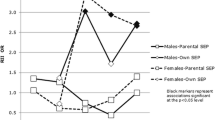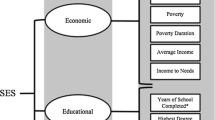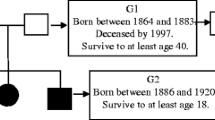Abstract
Investigations of socioeconomic status (SES) and health during the transition to adulthood in the United States are complicated by the later and more varied transitions in residence, employment, schooling, and social roles compared with previous generations. Parental SES is an important influence during adolescence but cannot sufficiently capture the SES of the independent young adult. Typical, single SES indicators based on income or education likely misclassify the SES of young adults who have not yet completed their education or other training, or who have entered the labor force early with ultimately lower status attainment. We use a latent class analysis (LCA) framework to characterize five intergenerational SES groups, combining multidimensional SES information from two time points—that is, adolescent (parental) and young adult (self) SES data. Associations of these groups with obesity, a high-risk health outcome in young adults, revealed nuanced relationships not seen using traditional intergenerational SES measures. In males, for example, a middle-class upbringing in adolescence and continued material advantage into adulthood was associated with nearly as high obesity as a working poor upbringing and early, detrimental transitions. This intergenerational typology of early SES exposure facilitates understanding of SES and health during young adulthood.

Similar content being viewed by others
References
Arbuckle, J. (1996). Full information estimation in the presence of incomplete data. In G. A. Marcoulides & R. E. Schumacker (Eds.), Advanced structural equation modeling: Issues and techniques (pp. 243–278). Mahwah, NJ: Erlbaum.
Baltrus, P. T., Lynch, J. W., Everson-Rose, S., Raghunathan, T. E., & Kaplan, G. A. (2005). Race/ethnicity, life-course socioeconomic position, and body weight trajectories over 34 years: The Alameda County Study. American Journal of Public Health, 95, 1595–1601.
Benoit-Smullyan, E. (1944). Status, status types, and interrelations. American Sociological Review, 9, 151–161.
Ben-Shlomo, Y., & Kuh, D. (2002). A life course approach to chronic disease epidemiology: Conceptual models, empirical challenges and interdisciplinary perspectives. International Journal of Epidemiology, 31, 285–293.
Blau, P. M., & Duncan, O. D. (1967). The American occupational structure. New York: John Wiley and Sons.
Bumpass, L., & McLanahan, S. (1989). Unmarried motherhood: Recent trends, composition, and black-white differences. Demography, 26, 279–286.
Burholt, V. (1999). Testing a behavioural and a developmental model of migration: A reevaluation of migration patterns among the elderly and why older people move. Environment and Planning A, 31, 2071–2088.
Carson, A. P., Rose, K. M., Catellier, D. J., Kaufman, J. S., Wyatt, S. B., Diez-Roux, A. V., & Heiss, G. (2007). Cumulative socioeconomic status across the life course and subclinical atherosclerosis. Annals of Epidemiology, 17, 296–303.
Clogg, C. C. (1980). Characterizing the class organization of labor market opportunity: A modified latent structure approach. Sociological Methods & Research, 8, 243–272.
Clogg, C. C. (1995). Latent class models. In G. Arminger, C. C. Clogg, & M. E. Sobel (Eds.), Handbook of statistical modeling for the social and behavioral sciences (pp. 311–359). New York: Plenum.
Collins, L. M., Hyatt, S. L., & Graham, J. W. (2000). LTA as a way of testing models of stage-sequential change in longitudinal data. In T. D. Little, K. U. Schnabel, & J. Baumert (Eds.), Modeling longitudinal and multiple-group data: Practical issues, applied approaches, and specific examples (pp. 147–161). Hillsdale, NJ: Erlbaum.
Crissey, S. R. (2005). Race/ethnic differences in the marital expectations of adolescents: The role of romantic relationships. Journal of Marriage and Family, 67, 697–709.
De Jong, G. F., & Madamba, A. B. (2001). A double disadvantage? Minority group, immigrant status, and underemployment in the United States. Social Science Quarterly, 82, 117–130.
Desantis, S. M., Houseman, E. A., Coull, B. A., Stemmer-Rachamimov, A., & Betensky, R. A. (2007). A penalized latent class model for ordinal data. Biostatistics, 9, 249–262.
Everitt, B. S. (1988). A finite mixture model for the clustering of mixed-mode data. Statistics & Probability Letters, 6, 305–309.
Everitt, B. S. (1993). Cluster analysis. London: Edward Arnold.
Featherman, D. L., & Hauser, R. M. (1978). Opportunity and change. New York: Academic Press.
Goldscheider, F. K., Thornton, A., & Yang, L.-S. (2001). Helping out the kids: Expectations about parental support in young adulthood. Journal of Marriage and Family, 63, 727–740.
Goodman, L. A. (1974). Exploratory latent structure analysis using both identifiable and unidentifiable models. Biometrika, 61, 215–231.
Goodman, E., Hinden, B. R., & Khandelwal, S. (2000). Accuracy of teen and parental reports of obesity and body mass index. Pediatrics, 106(1,Pt 1), 52–58.
Gordon-Larsen, P., Adair, L. S., Nelson, M. C., & Popkin, B. M. (2004). Five-year obesity incidence in the transition period between adolescence and adulthood: The national longitudinal study of adolescent health. The American Journal of Clinical Nutrition, 80, 569–575.
Greenland, S. (2004). Model-based estimation of relative risks and other epidemiologic measures in studies of common outcomes and in case-control studies. American Journal of Epidemiology, 160, 301–305.
Hagenaars, J., & McCutcheon, A. C. (2002). Applied latent class analysis models. New York: Cambridge University Press.
Hallqvist, J., Lynch, J., Bartley, M., Lang, T., & Blane, D. (2004). Can we disentangle life course processes of accumulation, critical period and social mobility? An analysis of disadvantaged socio-economic positions and myocardial infarction in the Stockholm Heart Epidemiology Program. Social Science & Medicine, 58, 1555–1562.
Harris, K. M., Gordon-Larsen, P., Chantala, K., & Udry, J. R. (2006). Longitudinal trends in race/ethnic disparities in leading health indicators from adolescence to young adulthood. Archives of Pediatrics & Adolescent Medicine, 160, 74–81.
Harris, K. M., Halpern, C. T., Whitsel, E., Hussey, J., Tabor, J., Entzel, P., & Udry, J. R. (2009). The national longitudinal study of adolescent health: Research design [WWW document]. Retrieved from http://www.cpc.unc.edu/projects/addhealth/design
Hart, C. L., Smith, G. D., & Blane, D. (1998a). Inequalities in mortality by social class measured at 3 stages of the lifecourse. American Journal of Public Health, 88, 471–474.
Hart, C. L., Smith, G. D., & Blane, D. (1998b). Social mobility and 21 year mortality in a cohort of Scottish men. Social Science & Medicine, 47, 1121–1130.
Heard, H. E. (2007). The family structure trajectory and adolescent school performance: Differential effects by race and ethnicity. Journal of Family Issues, 28, 319–354.
Holtgrave, D. R., & Crosby, R. (2006). Is social capital a protective factor against obesity and diabetes? Findings from an exploratory study. Annals of Epidemiology, 16, 406–408.
House, J. S., & Harkins, E. B. (1975). Why and when is status inconsistency stressful? The American Journal of Sociology, 81, 395–412.
Iacovou, M. (2002). Regional differences in the transition to adulthood. The Annals of the American Academy of Political and Social Science, 580, 40–69.
James, S. A., Fowler-Brown, A., Raghunathan, T. E., & Van Hoewyk, J. (2006). Life-course socioeconomic position and obesity in African American Women: The Pitt County study. American Journal of Public Health, 96, 554–560.
Jensen, L., & Slack, T. (2003). Underemployment in America: Measurement and evidence. American Journal of Community Psychology, 32, 21–31.
Jorgensen, M., & Hunt, L. (1996). Mixture model clustering of data sets with categorical and continuous variables. In D. L. Dowe, K. B. Korb, & J. J. Oliver (Eds.), Proceedings of the conference, information, statistics and induction in science (pp. 375–384). Melbourne, Australia: World Scientific.
Kalleberg, A. (1988). Comparative perspectives on work structures and inequality. Annual Review of Sociology, 14, 203–225.
Kaplan, D. (2004). The Sage handbook of quantitative methodology in the social sciences. Newbury Park, CA: Sage Publications.
Kaufman, L., & Rousseeuw, P. J. (1990). Finding groups in data: An introduction to cluster analysis. New York: John Wiley and Sons.
Kawachi, I., & Berkman, L. F. (2001). Social ties and mental health. Journal of Urban Health, 78, 458–467.
Kawachi, I., Kim, D., Coutts, A., & Subramanian, S. (2004). Commentary: Reconciling the three accounts of social capital. International Journal of Epidemiology, 33, 682–690.
Kim, D., Subramanian, S. V., Gortmaker, S. L., & Kawachi, I. (2006). US state- and county-level social capital in relation to obesity and physical inactivity: A multilevel, multivariable analysis. Social Science & Medicine, 63, 1045–1059.
Kleinbaum, D. G., Kupper, L. L., Muller, K. E., & Nizam, A. (1998). Applied regression analysis and other multivariate methods (3rd ed., pp. 250–251). Pacific Grove: Duxbury Thomson Learning.
Kreider, R. M., & Fields, J. (2005). Living arrangements of children: 2001 (Current population reports P70-104). Washington, DC: U.S. Census Bureau.
Krieger, N., Williams, D. R., & Moss, N. E. (1997). Measuring social class in US public health research: Concepts, methodologies, and guidelines. Annual Review of Public Health, 18, 341–378.
Kuh, D., Ben-Shlomo, Y., Lynch, J., Hallqvist, J., & Power, C. (2003). Life course epidemiology. Journal of Epidemiology and Community Health, 57, 778–783.
Lanza, S. T., Flaherty, B. P., & Collins, L. M. (2003). Latent class and latent transition analysis. In J. A. Schinka & W. F. Velicer (Eds.), Handbook of psychology: Vol. 2. Research methods in psychology (pp. 663–685). Hoboken, NJ: Wiley.
Lanza, S. T., Collins, L. M., Lemmon, D. R., & Schafer, J. L. (2007). PROC LCA: A SAS procedure for latent class analysis. Structural Equation Modeling: A Multidisciplinary Journal, 14, 671–694.
Lazarsfeld, P., & Henry, N. (1968). Latent structure analysis. New York: Houghton-Mifflin.
Lin, T. H., & Dayton, C. M. (1997). Model selection information criteria for non-nested latent class models. Journal of Educational and Behavioral Statistics, 22, 249–264.
Lumley, T., Kronmal, R., & Ma, S. (2006). Relative risk regression in medical research: Models, contrasts, estimators, and algorithms (UW Biostatistics Working Paper No. 293). Berkeley, CA: The Berkeley Electronic Press (bepress).
Lynch, J. W., Kaplan, G. A., & Shema, S. J. (1997). Cumulative impact of sustained economic hardship on physical, cognitive, psychological, and social functioning. The New England Journal of Medicine, 337, 1889–1895.
McCutcheon, A. C. (1987). Latent class analysis. Beverly Hills, CA: Sage Publications.
McLachlan, G. J., & Peel, D. (2000). Finite mixture models. New York: John Wiley.
McLanahan, S. (1985). Family structure and the reproduction of poverty. The American Journal of Sociology, 90, 873–901.
McLanahan, S. (2004). Diverging destinies: How children are faring under the second demographic transition. Demography, 41, 607–627.
McLoyd, V. C., Cauce, A. M., Takeuchi, D., & Wilson, L. (2000). Marital processes and parental socialization in families of color: A decade review of research. Journal of Marriage and the Family, 62, 1070–1093.
McNutt, L. A., Wu, C., Xue, X., & Hafner, J. P. (2003). Estimating the relative risk in cohort studies and clinical trials of common outcomes. American Journal of Epidemiology, 157, 940–943.
McTigue, K. M., Garrett, J. M., & Popkin, B. M. (2002). The natural history of the development of obesity in a cohort of young U.S. adults between 1981 and 1998. Annals of Internal Medicine, 136, 857–864.
Messineo, M. (2005). Influence of expectations for parental support on intergenerational coresidence behavior. Journal of Intergenerational Relationships, 3(3), 47–64.
Moore, S., Daniel, M., Paquet, C., Dube, L., & Gauvin, L. (2009). Association of individual network social capital with abdominal adiposity, overweight and obesity. Journal of Public Health, 31, 175–183.
Moors, G. (2008). The valued child. In search of a latent attitude profile that influences the transition to motherhood. European Journal of Population, 24, 33–57.
Muthén, L. K., & Muthén, B. O. (1998–2006). Mplus user’s guide (4th ed.). Los Angeles, CA: Muthen & Muthen.
NHLBI. (1998). Clinical guidelines on the identification, evaluation, and treatment of overweight and obesity in adults: The evidence report. Obesity Research, 6(Suppl), 51S–209S.
Nylund, K. L. (2007a). Deciding on the number of classes in latent class analysis and growth mixture modeling: A Monte Carlo simulation study. Structural Equation Modeling, 14, 535–569.
Nylund, K. L. (2007b). Latent transition analysis: Modeling extensions and an application to peer victimization (Unpublished doctoral dissertation). University of California, Los Angeles.
Oakes, J. M., & Rossi, P. H. (2003). The measurement of SES in health research: Current practice and steps toward a new approach. Social Science & Medicine, 56, 769–784.
Ogden, C. L., Carroll, M. D., Curtin, L. R., McDowell, M. A., Tabak, C. J., & Flegal, K. M. (2006). Prevalence of overweight and obesity in the United States, 1999–2004. JAMA, 295, 1549–1555.
Osgood, D. W., Ruth, G., Eccles, J. S., Jacobs, J. E., & Barber, B. L. (2004). Six paths to adulthood: Fast starters, parents without careers, educated partners, educated single, working singles, and slow starters. In R. A. Settersten, F. F. Furstenberg, & R. G. Rumbaut (Eds.), On the frontier of adulthood: Theory, research, and public policy (pp. 320–355). Chicago, IL: University of Chicago Press.
Pastor, D. A., Barron, K. E., Miller, B. J., & Davis, S. L. (2006). A latent profile analysis of college students' achievement goal orientation. Contemporary Educational Psychology, 32, 8–47.
Pollitt, R. A., Rose, K. M., & Kaufman, J. S. (2005). Evaluating the evidence for models of life course socioeconomic factors and cardiovascular outcomes: A systematic review. BMC Public Health, 5, 7.
Putnam, R. D. (2000). Bowling alone: The collapse and revival of American community. New York: Simon and Schuster.
Rindfuss, R. R. (1991). The young adult years: Diversity, structural change, and fertility. Demography, 28, 493–512.
Rosner, B. (2000). Fundamentals of biostatistics (5th ed.). Pacific Grove, CA: Duxbury Thomson Learning.
Rosvall, M., Chaix, B., Lynch, J., Lindstrom, M., & Merlo, J. (2006). Similar support for three different life course socioeconomic models on predicting premature cardiovascular mortality and all-cause mortality. BMC Public Health, 6, 203.
Sandefur, G. D., Mclanahan, S., & Wojtkiewicz, R. A. (1992). The effects of parental marital status during adolescence on high school graduation. Social Forces, 71, 103–121.
Scharoun-Lee, M., Adair, L. S., Kaufman, J. S., & Gordon-Larsen, P. (2009). Obesity, race/ethnicity and the multiple dimensions of socioeconomic status during the transition to adulthood: A factor analysis approach. Social Science & Medicine, 68, 708–716.
Schoeni, R., & Ross, K. (2004). Material Assistance from Families during the Transition to Adulthood. In R. A. Settersten, F. F. Furstenberg, & R. G. Rumbaut (Eds.), On the frontier of adulthood: Theory, research, and public policy (pp. 396–416). Chicago, IL: University of Chicago Press.
Schoon, I. (2008). A transgenerational model of status attainment: The potential mediating role of school motivation and education. National Institute Economic Review, 205(1), 72–82.
Schwartz, G. (1978). Estimating the dimensions of a model. Annals of Statistics, 6, 461–464.
Sewell, W. H., & Hauser, R. M. (1975). Education, occupation & earnings: Achievement in the early career. New York: Academic Press.
Shanahan, M. J., Porfeli, E. J., Mortimer, J. T., & Erickson, L. D. (2004). Subjective age identity and the transition to adulthood: When do adolescents become adults? In R. A. Settersten, F. F. Furstenberg, & R. G. Rumbaut (Eds.), On the frontier of adulthood: Theory, research, and public policy (pp. 225–255). Chicago, IL: University of Chicago Press.
Singh-Manoux, A., Ferrie, J. E., Chandola, T., & Marmot, M. (2004). Socioeconomic trajectories across the life course and health outcomes in midlife: Evidence for the accumulation hypothesis? International Journal of Epidemiology, 33, 1072–1079.
Slack, T., & Jensen, L. (2002). Race, ethnicity and underemployment in nonmetropolitan America: A 30-year profile. Rural Sociology, 67, 208–233.
Smith, G. D., & Hart, C. (2002). Life-course socioeconomic and behavioral influences on cardiovascular disease mortality: The collaborative study. American Journal of Public Health, 92, 1295–1298.
Snyder, A. R., & McLaughlin, D. K. (2004). Female-headed families and poverty in rural America. Rural Sociology, 69, 127–149.
Sobal, J. (1991). Obesity and socioeconomic status: A framework for examining relationships between physical and social variables. Medical Anthropology, 13, 231–247.
Sobal, J., & Stunkard, A. J. (1989). Socioeconomic status and obesity: A review of the literature. Psychological Bulletin, 105, 260–275.
StataCorp. (2007). Stata statistical software: Release 9.2. College Station, TX: Stata Corporation.
Teachman, J. D., Tedrow, L. M., & Crowder, K. D. (2000). The changing demography of America’s families. Journal of Marriage and the Family, 62, 1234–1246.
Thomson, E., Hanson, T. L., & McLanahan, S. S. (1994). Family structure and child well-being: Economic resources vs. parental behaviors. Social Forces, 73, 221–242.
Uebersax, J. (2001–2003). Latent class analysis. Retrieved from http://www.john-uebersax.com/stat
Usdansky, M., & McLanahan, S. (2003). Looking for Murphy Brown: Are college-educated, single mothers unique? (Working Paper No. 03-05-FF). Princeton, NJ: Center for Research on Child Wellbeing.
Vermunt, J. K., & Magidson, J. (2000). Latent class cluster analysis. In J. Hagenaars & A. C. McCutcheon (Eds.), Applied latent class analysis (pp. 89–106). Cambridge, UK: Cambridge University Press.
Wothke, W. (2000). Longitudinal and multi-group modeling with missing data. In T. D. Little, K. U. Schnabel, & J. Baumert (Eds.), Modeling longitudinal and multiple group data: Practical issues, applied approaches and specific examples (pp. 219–240). Mahwah, NJ: Lawrence Erlbaum Associates.
Wright, E. O. (1979). Class structure and income determination. New York: Academic Press.
Zhan, M., & Pandey, S. (2004). Postsecondary education and economic well-being of single mothers and single fathers. Journal of Marriage and Family, 66, 661–673.
Zou, G. (2004). A modified poisson regression approach to prospective studies with binary data. American Journal of Epidemiology, 159, 702–706.
Acknowledgements
This analysis was supported by the National Institutes of Health, NICHD, Ruth L. Kirshstein (NRSA) F31-HD049334 and R01HD057194. This work was done while Dr. Scharoun-Lee was a graduate student at the University of North Carolina. The authors would like to thank Dr. Glen Elder for his valuable comments on previous drafts of this manuscript. We also thank Mr. Tom Swasey for assistance with graphic analysis. This research uses data from Add Health, a program project directed by Kathleen Mullan Harris and designed by J. Richard Udry, Peter S. Bearman, and Kathleen Mullan Harris at the University of North Carolina at Chapel Hill, and funded by Grant P01-HD31921, from the Eunice Kennedy Shriver National Institute of Child Health and Human Development, with cooperative funding from 23 other federal agencies and foundations. Special acknowledgment is due Ronald R. Rindfuss and Barbara Entwisle for assistance in the original design. Information on how to obtain the Add Health data files is available on the Add Health website (http://www.cpc.unc.edu/addhealth). No direct support was received from Grant P01-HD31921 for this analysis. There are no potential or real conflicts of financial or personal interest with the financial sponsors of the scientific project.
Author information
Authors and Affiliations
Corresponding author
Appendix
Appendix
Rights and permissions
About this article
Cite this article
Scharoun-Lee, M., Gordon-Larsen, P., Adair, L.S. et al. Intergenerational Profiles of Socioeconomic (Dis)advantage and Obesity During the Transition to Adulthood. Demography 48, 625–651 (2011). https://doi.org/10.1007/s13524-011-0024-5
Published:
Issue Date:
DOI: https://doi.org/10.1007/s13524-011-0024-5




